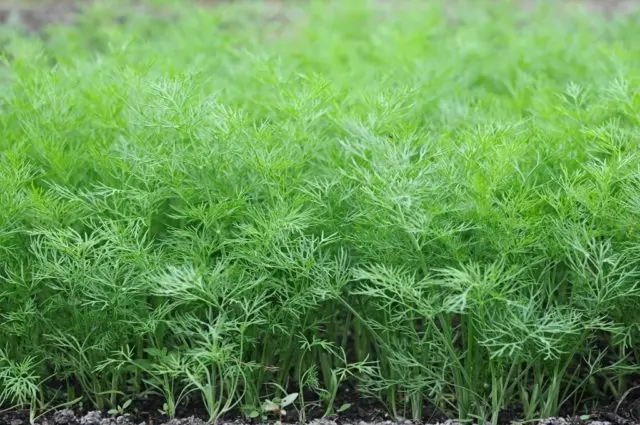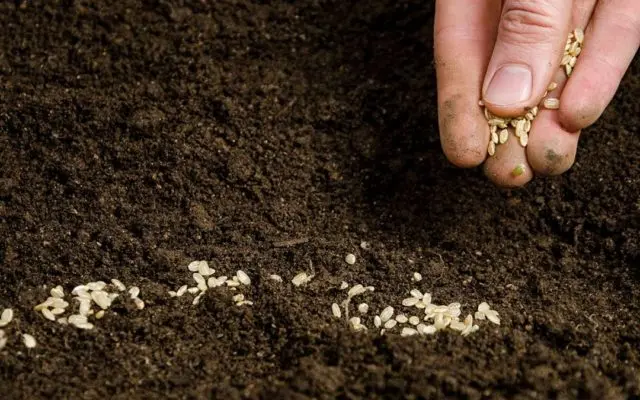Contents
Dill Salute is an annual crop of the Umbelliferae family. This plant with a strong spicy smell is a representative of the ancient species of fragrant dill. Even the inhabitants of Central and Asia Minor, East India, Egypt grew it as a valuable spice and knew about the medicinal properties of this plant. Dill began to be cultivated in Our Country and, over time, many varieties with good characteristics were obtained. Specialists of the All- Research Institute of Selection and Seed Production of Vegetable Crops in the mid-90s of the last century bred fragrant dill variety Salyut. Its difference is in late flowering, and hence in the high productivity of green mass. The culture began to be used for breeding on an industrial scale. Today, Salyut dill is successfully grown both in greenhouses and in the open field.
Description of dill Salute
The description of dill variety Salyut gives an idea of its benefits. This is a powerful shrub with dark green pinnate leaves up to 16 cm long, closely spaced on the stem. From one outlet can grow from 10 to 30 pieces. A single straight stem reaches a height of one meter. After the onset of the flowering period, large umbrellas are formed at its top, with flat, light brown seeds.

Greens are used fresh, but also retain their qualities when dried. Due to the unpretentiousness of dill variety Salyut has a wide area of growth. Its plantings can be found in the garden plots of Ukraine, Moldova, Our Country, Belarus.
Productivity
Usually dill Salute is grown on greens. Like all representatives of late-ripening varieties, the plant has powerful rosettes with a large number of leaves, which means it has a high yield. It takes a long time to wait for maturation (about 2 months), but it fully pays off.
Dill picking starts in June. From the moment of emergence of seedlings to the formation of mature greenery, it usually takes from 45 to 66 days. After the first harvest, they wait until the dill sprigs grow back in order to carry out the second stage of the harvest. Before the flowering period of the bushes, there can be four such visits. As a result, from 100 to 200 g of succulent leaves with a pleasant, slightly tart aroma are cut from one bush. From one sq. m plot (with good care and favorable weather conditions) during the summer they collect up to 5 kg of greens of this dill variety.
Stability
The Salyut variety is a representative of the “new generation” bush dill. Breeders made sure that the newly bred varieties have unique properties. One of them is high immunity. Salute dill variety is adapted to any climatic conditions, easily tolerates weather changes, is not susceptible to diseases and attacks of garden pests. Pre-sowing preparation and processing of its seeds helps to increase the resistance of dill.
Advantages and disadvantages
The most valuable varietal trait of the variety was the long period of green mass development. The plant is able to give a rich harvest of greenery several times during the summer. After the next collection, the leaves actively grow again. During a long growing season, green twigs accumulate a large amount of vitamins, trace elements and useful essential oils. These qualities determine the main advantages of the variety:
- high yield, the ability to carry out several collections of green mass of dill per season;
- resistance to diseases and pests;
- unpretentiousness;
- excellent taste and aroma;
- high medicinal properties of dill.
The culture also has some disadvantages, which are more common in greenhouse cultivation. With a dense planting, the plant develops worse, and its roots are prone to rotting.
Rules of landing
Salut dill is a self-pollinating crop. Like all late-ripening varieties, it has two sowing periods:
- in mine;
- at the end of August and September.
Harvest start dates:
- in June – they begin to collect greens;
- at the end of August comes the turn of collecting umbrellas.
For growing dill Salute from seeds, neutral or slightly alkaline fertile soil is suitable. When choosing a place to plant, you need to consider that a sufficient amount of light and heat is necessary for the growth of dill. The site should be located on the south sunny side, in a place where there is no close occurrence of groundwater. Celery or fennel growing nearby can cause cross-pollination and the loss of valuable varietal qualities of dill.
Before sowing, the soil is fed with any organic fertilizer. This can be manure (3,5 kg per sq. M), compost (5 kg per sq. M) or any complex fertilizer.
Before sowing, dill seeds Salut need special preparation. This will help improve their germination. Use one of the following methods:
- the seeds are immersed in heated spring or melt water and left for a day to swell;
- kept in an infusion of ash (2 tablespoons per liter of water) for two days;
- treated with growth stimulants (Humate, Zircon).
Sowing is carried out according to the following scheme:
- Wide furrows 2 cm deep are made on the site (row spacing is 20 cm), they are well shed with water.
- Carry out sowing in a continuous way. About 30 seeds should fit per linear meter of furrow.
- Sprinkle with soil on top. Seeds should be planted 2 cm into the soil.

Cultivation technology
The quality of the crop depends on proper, timely care. Procedures are standard:
- weeding and loosening;
- watering;
- fertilizer.
For the active growth of dill, the soil must have good water and air permeability. Roots need a significant amount of oxygen. In addition, their prolonged contact with stagnant moisture is unacceptable. To do this, after each watering, a thorough loosening of the soil and removal of weeds are carried out.
Water plantings as the soil dries out. Insufficient moisture causes wilting of the leaves, and abundant moisture is a common cause of root rot.
Top dressing is usually carried out once, before sowing. But with a slow growth of the culture, it is fed again. Carry out root application of manure to the ground (for 10 liters of water – half a liter of fertilizer) and urea (for 10 liters of water – 1 tsp)
Diseases and pests
Under normal conditions, salut dill is usually not susceptible to disease. The following situations can be risk factors:
- dill planted too densely;
- soil moisture is very high.
Under such conditions, the plant may develop root rot, blackleg, and fungal diseases.
Of the garden pests, the following are the most dangerous for Salute dill:
- ruled stinkweed;
- wireworm;
- coriander seed-eater;
- aphid.
Greens are not recommended to be treated with insecticides. Prevention of diseases is carried out in a timely manner, and, if necessary, they try to get by with folk remedies.
Conclusion
Dill Salute refers to crops that do not require complex care. Therefore, even a novice gardener can safely start breeding a variety, observing the simplest rules of planting and care.
Many gardeners fell in love with Salut dill, as evidenced by numerous reviews and photos. Thick greens are used as food immediately or canned for use in the winter. To do this, the green branches are finely chopped, laid out on baking sheets and dried in the oven or in the fresh air in the shade. You can pickle the grass by putting it in sterilized jars. The spice is well stored in a dry, cool, well-ventilated area.









